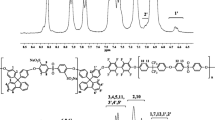Abstract
A series of sulfonated poly(ether ether ketone)s were successfully synthesized via nucleophilic displacement condensation. The membranes are accordingly cast from their DMSO solutions, and fully characterized by determining the ion-exchange capacity, water uptake, dimensional stabilities, proton conductivity and mechanical properties. Among membranes, the block-7c-3 was successfully synthesized by the reaction of Block-6c with chlorosulfonic acid, with the feed ratio of repeated unit to chlorosulfonic acid of 1:8. The experimental results show that the membrane from block-7c-3 has good mechanical, oxidative and dimensional stabilities together with high proton conductivity (5.15 × 10−2 Scm−1) at 80 °C under 100 % relative humidity. The membranes also possess excellent thermal and dimensional stabilities, in this respect, they are potential and promising proton conducting membrane material for PEM full cell applications.








Similar content being viewed by others
References
Prater KB (1994) Polymer electrolyte fuel cells: a review of recent developments. J Power Sources 51:129–144
Thomas K (1996) Fuel cells for transport: can the promise be fulfilled technical requirements and demands from customers. J Power Sources 61:61–69
Di Noto V, Lavina S, Giffin GA (2011) Polymer electrolytes: present, past and future. Electrochim Acta 57:4–13
Borroni-Bird CE (1996) Fuel cell commercialization issues for light-duty vehicle applications. J Power Sources 61:33–48
Rikukawa M, Sanui K (2000) Proton-conducting polymer electrolyte membranes based on hydrocarbon polymers. Prog Polym Sci 25:1463
Di Noto V, Zawodzinski TA, Ml HA (2012) Polymer electrolytes for a hydrogen economy. Int J Hydrog Energy 37(7):6120–6131
Jacques R, Deborah JJ (2003) Non-fluorinated polymer materials for proton exchange membrane fuel cell. Annu Rev Mater Res 33:503–555
Gupta B, Buchi FN, Scherer GG (1993) Materials research aspects of organic solid proton conductors. Solid State Ionics 61:213–218
Flint SD, Slade RCT (1997) Investigation of radiation-grafted PVDF-g-polystyrene- sulfonic-acid ion exchange membranes for use in hydrogen oxygen fuel cells. Solid State Ionics 97:299–307
Jones JD, Roziere J (2001) Recent advances in the functionalisation of polybenzimidazole and polyetherketone for fuel cell applications. J Membr Sci 185:41–58
Bae JM, Honma I, Murata M (2002) Properties of selected sulfonated polymers as proton-conducting electrolytes for polymer electrolyte fuel cells. Solid State Ionics 147:189–194
Roziere J, Jones DJ, Marrony M (2001) On the doping of sulfonated polybenzimidazole with strong bases. Solid State Ionics 145:61–68
Giffin GA, Piga M, Lavina S (2012) Characterization of sulfated-zirconia/Nafion composite membranes for proton exchange membrane fuel cells. J Power Sources 198:66–75
Tezuka T, Tadanaga K, Hayashi A, Tatsumisago M (2006) Inorganic–organic hybrid membranes with anhydrous proton conduction prepared from 3-aminopropyltriethoxysilane and sulfuric acid by the sol–gel method. J Am Chem Soc 128:16470–16471
Di Noto V, Piga M, Giffin GA (2011) New sulfonated poly (p-phenylenesulfone)/poly (1-oxotrimethylene) nanocomposite proton-conducting membranes for PEMFCs. Chem Mater 23(20):4452–4458
Asano N, Miyatake K, Watanabe M (2004) Hydrolytically stable polyimide inomomer for fuel cell applilcations. Chem Mater 16:2841–2843
Asano N, Aoki M, Suzuki S, Miyatake K, Uchida H, Watanabe M (2006) Aliphatic/aromatic polyimide ionomers as a proton conductive membrane for fuel cell applications. J Am Chem Soc 128:1762–1769
Roy A, Hickner MA, Yu X (2006) Influence of chemical composition and sequence length on the transport properties of proton exchange membranes. J Polym Sci B Polym Phys 44:2226–2239
Ghassemi H, McGrath JE, Zawodzinski J (2006) Multiblock sulfonated–fluorinated poly(arylene ether)s for a proton exchange membrane fuel cell. Polymer 47:4132–4139
Matsumura S, Hlil R, Lepiller C, Gaudet J, Guay D, Hay AS (2008) Ionomers for proton exchange membrane fuel cells with sulfonic acid groups on the end groups: novel linear aromatic poly(sulfide − ketone)s. Macromolecules 41:277–280
Matsumura S, Hlil AR, Lepiller C, Gaudet J, Guay D, Shi Z-Q, Holdcroft S, Hay AS (2008) Macromolecules 41:281–284
Tian SH, Meng YZ, Hay AS (2009) Membranes from poly(aryl ether)-based ionomers containing randomly distritbuted nanoclusters of 6 or 12 sulfonic acid groups. Macromolecules 42:1153–1160
Pang J, Zhang H, Li XF, Jiang ZH (2007) Novel wholly aromatic sulfonated poly(arylene ether) copolymers containing sulfonic acid groups on the pendants for proton exchange membrane materials. Macromolecules 40:9435–9442
Yasuda T, Li Y, Miyatake K, Hirai M, Nanasawa M, Watanabe M (2006) Synthesis and properties of polyimides bearing acid groups on long pendant aliphatic chains. J Polym Sci A Polym Chem 44:3995–4005
Hu H, Xiao M, Wang SJ, Meng YZ (2010) Poly(fluorenyl ether ketone)ionomers containing separated hydrophilic multiblocks usedin fuel cells as proton exchange membranes. Int J Hydrog Energy 35:682–9
Shang XY, Tian SH, Kong LH, Meng YZ (2005) Synthesis and characterization of sulfonated fluorene-containing poly(arylene ether ketone) for proton exchange membrane. J Membr Sci 266:94–101
Wang SJ, Luo JJ, Meng YZ (2012) Design, synthesis and properties of polyaromatics with hydrophobic and hydrophilic long blocks as proton exchange membrane for PEM fuel cell application. Int J Hydrog Energy 37:4545–4552
Acknowledgments
The authors would like to thank for the Natural Science Foundation of China (21306124) financial support of this work and Taiyuan University of Technology College Students’ Innovative Entrepreneurial Training Plan (Grant 13060).
Author information
Authors and Affiliations
Corresponding author
Rights and permissions
About this article
Cite this article
Luo, J.J., Song, Y.H., Wang, Y.L. et al. Synthesis and properties of fluorene-containing sulfonated poly (ether ether ketone) as proton-exchange membrane for PEM fuel cell application. J Polym Res 22, 41 (2015). https://doi.org/10.1007/s10965-015-0683-9
Received:
Accepted:
Published:
DOI: https://doi.org/10.1007/s10965-015-0683-9




